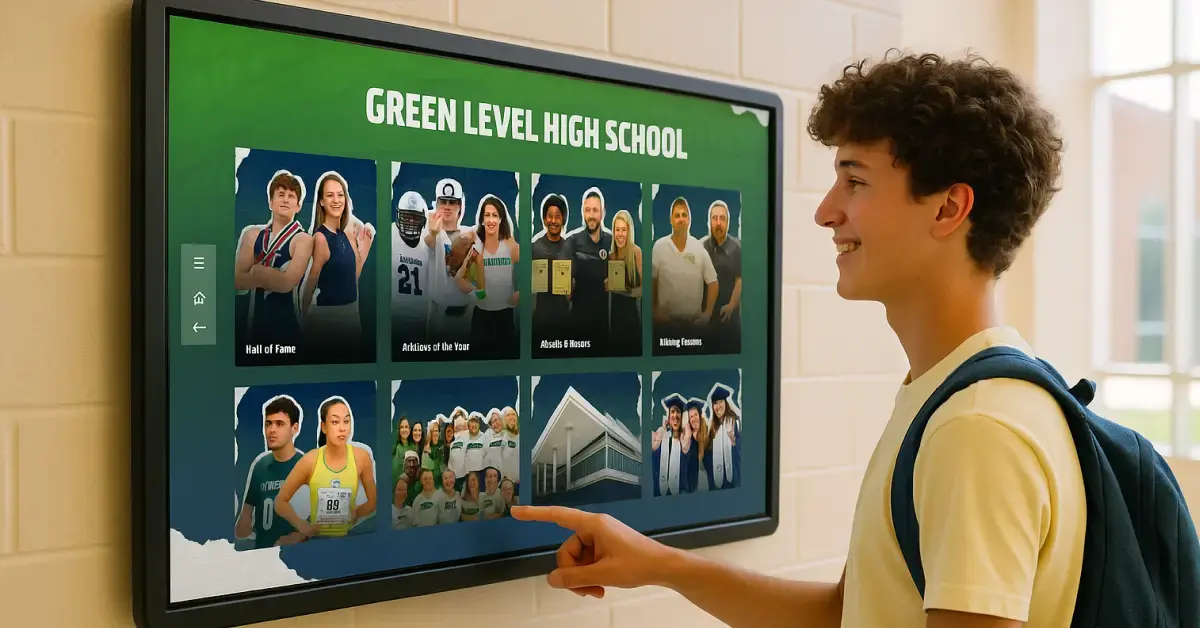4 Signs It's Time to Modernize Your Traditional High School Hall of Fame
- Traditional athletic halls of fame can’t keep up with modern school needs, limiting recognition and preservation of your athletic legacy.
- Limited space in trophy cases means lost history and forgotten achievements that a digital hall of fame can keep alive.
- Traditional halls of fame require in-person viewing and miss out on key opportunities to engage your community.
- Digital halls of fame save time with instant updates, making athlete recognition faster and easier than ever.
Your school’s athletic legacy deserves more than dusty trophies and crowded walls. Yet many high school athletic directors are still using a traditional hall of fame to showcase student achievement. And year after year, they run into the same challenges: space limitations, time consuming updates, and tough decisions about what history to put on display.
Many athletic departments are opting to modernize their traditional halls of fame with a digital solution. Here’s why it’s time for you to do the same.Downsides to a traditional hall of fame
1. Space runs out fast
Congratulations – your varsity soccer team just won the state championship! Now you have a big new trophy that you’ll want to put on display for every student, staff member, and visitor to see.
The problem? There’s no room in your trophy case.
.webp?width=1200&height=628&name=Make%20sure%20your%20image%20fills%20this%20entire%20space%20(2).webp)
Limited space is the #1 problem with physical halls of fame. Walls, gym ceilings, and trophy cases can only hold so much.
Solving the space challenge can be overwhelming. So much so, that many athletic directors end up procrastinating their hall of fame changes or just never making updates at all.
The result? Outdated, cluttered halls of fame that don’t showcase the full story of their athletic department’s achievements and history.
2. History gets lost
Limited space also means you have to make tough decisions about which “old history” to remove to make room for the new.
Maybe you decide to remove the 1987 soccer state championship trophy to make room for the new one. Do you put the old one in a forgotten storage closet? Do you throw it out altogether?
What happens when the 1987 team captain comes back to your campus to show his family his championship trophy and…it’s not there?
Traditional halls of fame make it extremely difficult to put the full history of your athletic department on display. You constantly have to make choices about what’s valuable to showcase, which can lead to important moments in your history being forgotten, or worse, alumni feeling unrecognized and undervalued.
And for Athletic Director Colin Fegeley, that's exactly why he sees the need for a digital hall of fame solution, "“Preserving the history and accomplishments for all of the kids that will come back and continue to call our school home over the rest of their lives is, to me, an important thing.”
3. Updates are slow and tedious
Plaques, trophies, and banners haven’t changed in decades, and neither has the process of getting them made.
It can easily take weeks to get a new plaque created. And let’s face it, getting it installed is probably not on your list of priorities. By the time you get it up on your already crowded physical hall of fame wall, the moment of celebration has already passed.
In today’s digital age, high school sports recognition needs to be faster and more accessible. Parents and athletes demand instant recognition. But with the amount of time and effort that traditional halls of fame require, you’re guaranteed to miss that real-time recognition for your community.
4. Recognition stays trapped on campus
So you’ve gone through the headache of adding a new championship plaque to your physical hall of fame. The reward for your effort is that people get to finally see it!
But that requires people to be onsite, in your athletic hallways, and there’s only a small fraction of your community that can be. There’s an even larger group of your fans — alumni, grandparents, former staff — that are not local to your campus.
Those fans probably follow your athletic department on social media, your website, and other digital platforms, but if you’re only updating your traditional hall of fame, you’re missing out on engaging this crucial group of fans in your community.
Digital vs. physical hall of fame: Why digital wins
If you’re experiencing these four major downsides that come with a traditional high school athletic hall of fame, it’s probably time to explore a digital hall of fame solution.
Digital halls of fame directly address the downsides of physical halls of fame and offer even more possibilities for student recognition.
- Recognize every achievement with no space limit. Digital halls of fame give you unlimited real estate to showcase every accomplishment and the stories behind them.
- Preserve your full athletic history. No need to throw away any school history. Share unlimited content on your digital hall of fame.
- Make updates in minutes. Fast & easy software allows you and your team to update your hall of fame in no time. Say goodbye to expensive third-party vendors that only slow down the process.
- Share beyond school walls. Generate a shareable link that allows anyone to access your digital hall of fame, no matter where they are.
See how Tecumseh Athletics turned their physical hall of fame into a digital version that gives them more room to share their athletic history.
How to start modernizing your traditional hall of fame
Transitioning from a physical hall of fame to a digital hall of fame can seem intimidating. But with the right tools, the move can be seamless. Plus, now is a great time to upgrade to a digital hall of fame!
Gipper Touch is a digital hall of fame solution built specifically for high school athletic directors and their teams. User-friendly software allows you to make updates fast, so you never fall behind on student recognition.
Digital hall of fame frequently asked questions
What is a digital hall of fame?
A digital hall of fame is an online platform that allows schools to showcase athletic achievements, history, individual recognitions, and more without the physical limitations of traditional trophy cases or wall displays.
Why are schools switching from traditional to digital halls of fame?
Many athletic departments are moving to digital halls of fame because traditional ones suffer from limited space, slow updates, and recognition that stays trapped on campus. Digital solutions solve these issues while preserving history and engaging a wider audience online.
How easy is it to update a digital hall of fame?
With the right digital hall of fame provider, like Gipper Touch, updates can be made in minutes—no need to wait weeks for plaques or depend on third-party vendors. This allows schools to celebrate accomplishments in real time.
Can people outside the school access a digital hall of fame?
Yes! Digital halls of fame can be shared via links or embedded on a school’s website, allowing alumni, families, and fans anywhere to view and celebrate achievements remotely

.webp)


